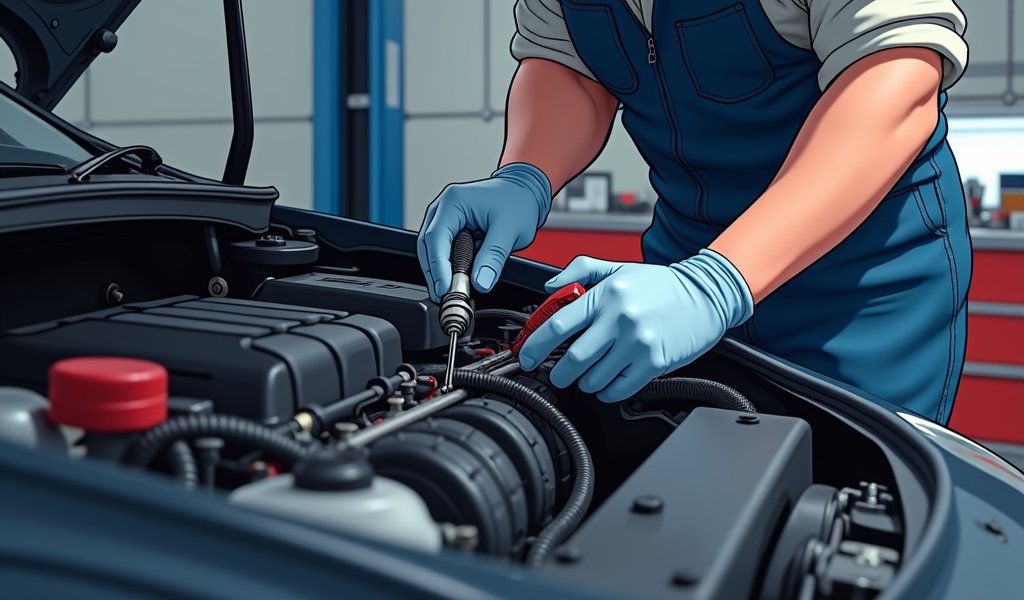Overview
This article explains how spark plug gap—the precise space between electrodes where voltage creates the spark for combustion—significantly impacts engine performance. The guide provides three professional tips: understanding manufacturer specifications, mastering proper gapping techniques, and optimizing gaps for specific performance needs, along with troubleshooting advice for common gap-related engine problems.
Table of Contents
- Introduction
- What Is a Spark Plug Gap?
- Pro Tip #1: Understanding Manufacturer Specifications
- Pro Tip #2: Perfect Gapping Techniques
- Pro Tip #3: Optimizing Gap for Performance
- Troubleshooting Common Gap-Related Issues
- Conclusion
- Frequently Asked Questions
Introduction
Let’s talk about the unsung hero of your engine’s performance – the spark plug gap. This tiny space might seem insignificant, but trust me, after 25 years under the hood, I can tell you it’s where all the magic happens. That little gap between electrodes is where voltage transforms into the spark that breathes life into your engine.
When set correctly, this precise measurement creates the perfect spark to ignite your air-fuel mixture, delivering clean, efficient combustion that keeps your engine purring like a contented cat. Get it wrong, though, and your vehicle might start running rougher than a teenager’s first attempt at driving stick.
Over the years, I’ve seen countless engines transformed simply by dialing in the correct spark plug gap specifications. It’s amazing how something measured in thousandths of an inch can make such a dramatic difference in how your car runs.
In this guide, I’m sharing three professional tips that’ll help you master spark plug gapping. These aren’t just theoretical concepts – they’re the same techniques I’ve used thousands of times in my shop to deliver peak engine performance to my customers.
What Is a Spark Plug Gap?
Think of your spark plug gap as nature’s perfect lightning storm in miniature form. It’s the precisely measured space between the center electrode (that small post in the middle) and the ground electrode (the curved metal arm extending from the side).
This tiny air space, typically ranging from 0.024 to 0.060 inches, is where electricity puts on an impressive performance. Voltage builds up in your ignition system until it has enough juice to jump across this gap – creating a spark that’s actually hotter than the surface of the sun. That intense heat is exactly what’s needed to ignite the compressed fuel-air mixture in your combustion chamber.
To properly work with spark plug gaps, you’ll need a few basic tools:
- A feeler gauge set (wire type is best for modern plugs)
- A spark plug gapping tool
- Clean cloths for handling plugs
- A small light or magnifier to see the gap clearly
These simple tools are the difference between guesswork and precision – and your engine can definitely feel the difference. As you get into complete car servicing, you’ll find that proper gapping becomes second nature, but it’s worth taking your time until then.

Pro Tip #1: Understanding Manufacturer Specifications
Here’s something I wish more DIYers understood: those spark plug gap specifications aren’t just suggestions – they’re carefully calculated numbers determined through thousands of hours of testing. Engineers have pinpointed the exact gap that optimizes your specific engine’s performance, fuel economy, and emissions.
Finding the correct specs is actually pretty straightforward if you know where to look:
- Your vehicle’s service manual (always my go-to source)
- The owner’s manual (usually tucked in the maintenance section)
- An emissions sticker under the hood
- Reputable online databases specific to your make and model
- A quick call to your dealership’s service department
For quick reference, most modern passenger vehicles typically want gaps between 0.035 and 0.045 inches. Performance vehicles often run tighter, around 0.028 to 0.032 inches, while some newer, high-efficiency engines might spec wider gaps up to 0.055 inches.
Now, there are legitimate reasons to consider adjusting beyond factory specs – but tread carefully. If you’ve installed a turbocharger or supercharger, you’ll want to reduce the gap slightly (about 0.003-0.005 inches) to prevent misfires under boost. Similarly, if you’re driving at high altitudes where the air is thinner, a slightly wider gap can help maintain proper combustion.
According to NGK Spark Plugs, one of the industry’s most trusted manufacturers, deviating from recommended gap specifications is one of the leading causes of premature plug failure. Their research shows that improper gapping can reduce plug life by up to 30% while simultaneously hurting performance.
Pro Tip #2: Perfect Gapping Techniques
Knowing the right gap is only half the battle – you’ve got to nail the technique too. Here’s how I’ve been gapping plugs since back when cassette tapes were still cool:
Measuring Current Gaps
- Hold the spark plug with the electrodes facing up and in good lighting
- Select the proper feeler gauge that matches your target gap
- Slide the gauge between the electrodes with a gentle touch – you should feel slight resistance but not forcing
- If it slides too easily, the gap’s too wide; if it won’t go in at all, it’s too narrow
Adjustment Techniques
- To widen the gap: Gently pull outward on the ground electrode using the notched end of your gapping tool
- To narrow the gap: Carefully tap the ground electrode on a soft wood surface (never use metal!)
- Work in small increments – about 0.002 inches at a time
- Never, ever apply pressure to the center electrode – it’s fragile and housed in ceramic that cracks easily
Common Mistakes to Avoid
- Using pliers directly on the electrodes (rookie move that’ll damage the plug)
- Bending the ground electrode back and forth (creates metal fatigue that’ll cause it to break)
- Adjusting a platinum or iridium plug by pressing on the precious metal center tip (instant damage to that expensive plug)
- Eyeballing the gap instead of measuring (even the pros don’t trust their eyes for this precision job)
After making any adjustment, always re-measure to verify accuracy. I’ve seen even tiny differences – just 0.002 inches – create noticeable performance changes, especially in modern engines with their sophisticated engine management systems.
When performing a complete spark plug replacement, take your time with each plug. It’s not a race, and the few extra minutes spent ensuring perfect gaps will pay dividends in engine performance.
Pro Tip #3: Optimizing Gap for Performance
Sometimes, like a chef adding a pinch more seasoning to a signature dish, you might want to fine-tune your spark plug gaps beyond factory specs. This isn’t for everyone or every vehicle, but in certain situations, it can unlock additional performance.
Wider gaps (0.002-0.004 inches over spec) might benefit:
- Naturally aspirated engines running lean mixtures
- Vehicles with upgraded ignition systems providing stronger spark
- Engines operating primarily at steady highway speeds
- Cars seeking slight improvements in fuel economy
A wider gap creates a larger, hotter spark that more effectively ignites lean fuel mixtures. It’s like using a bigger match – it gives the flame a better chance to spread quickly through the combustion chamber. However, wider gaps demand more voltage, which means your ignition system needs to be up to the task.
Narrower gaps (0.002-0.004 inches under spec) work better for:
- Turbocharged or supercharged engines
- High-compression performance engines
- Vehicles using nitrous oxide systems
- Applications where misfires occur under heavy load
With narrower gaps, the spark requires less voltage to jump, ensuring reliable ignition under the higher cylinder pressures found in performance applications. It’s like shortening the distance a long jumper needs to clear – the success rate goes way up.
Just be aware that these gap adjustments will affect your spark plug life. Wider gaps tend to accelerate electrode wear, potentially reducing plug longevity by 10-15%, while narrower gaps might lead to carbon buildup if combustion isn’t as complete. It’s all about finding the sweet spot for your specific setup.
Motor Trend’s research shows that custom gapping can yield up to 2-3% power gains in some applications, especially when combined with other tuning adjustments – not huge numbers, but meaningful for enthusiasts seeking every last bit of performance.

Troubleshooting Common Gap-Related Issues
After 25 years of diagnosing engine problems, I’ve developed a sixth sense for gap-related issues. Your engine has a language all its own, and once you learn to listen, it’ll tell you exactly what’s wrong.
Symptoms of Gaps That Are Too Wide
- Misfires under acceleration (especially noticeable when merging onto highways)
- Hard starting, particularly in cold weather when your battery’s already struggling
- Rough idle that seems to smooth out as RPMs increase
- Check engine light with misfire codes (P0300 series)
Symptoms of Gaps That Are Too Narrow
- Poor fuel economy (the engine’s consuming fuel but not burning it efficiently)
- Sluggish acceleration despite the engine seeming to run smoothly
- Black, sooty deposits on spark plugs when you remove them
- Fouled plugs that need replacement more frequently than normal
If you’re experiencing these symptoms after checking and adjusting your gaps, the problem might lie elsewhere in your ignition system. Consider:
- Worn or damaged spark plug electrodes
- Deteriorated ignition wires or coils
- Vacuum leaks affecting the air-fuel mixture
- Fuel delivery issues
Remember that gap adjustment isn’t a cure-all for ignition problems, but it’s an excellent starting point for troubleshooting. I always tell my customers that servicing your car regularly prevents many of these issues before they start.
When diagnosing spark plug issues, be systematic. Pull one plug at a time, inspect it, check its gap, and reinstall it before moving to the next. This methodical approach helps isolate problem cylinders and prevents the confusion that comes from having multiple plugs out at once.
Conclusion
Getting your spark plug gap specifications right is like finding the perfect fit for a key in a lock – when everything aligns correctly, the engine’s power is unleashed with smooth, efficient operation. Those tiny measurements, sometimes just the thickness of a human hair, make all the difference between an engine that struggles and one that sings.
Remember our three pro tips: understand what the manufacturer recommends and why, master the physical techniques of measuring and adjusting gaps, and know when and how to optimize for your specific driving conditions. These skills put you in the driver’s seat of your vehicle’s performance and longevity.
I’ve spent decades watching customers’ faces light up when their engines come back to life after something as simple as correcting spark plug gaps. It’s not glamorous work, but it’s incredibly satisfying, like a doctor finding the perfect prescription that makes all the symptoms disappear.
Whether you’re maintaining your daily driver or tweaking a weekend project car, taking the time to properly gap your spark plugs is one of the simplest yet most effective ways to keep your engine running at its absolute best. Your engine works hard for you – return the favor with properly gapped spark plugs, and it’ll reward you with thousands of miles of trouble-free operation.
Frequently Asked Questions
What happens if spark plug gap is too big?
A gap that’s too large can cause misfires, hard starting, and rough idle. The spark may not have enough voltage to jump across the wider distance, especially under high compression or load conditions.
What happens if spark plug gap is too small?
A gap that’s too small creates a weak spark that produces incomplete combustion, leading to poor fuel economy and sluggish performance. You’ll also notice black, sooty deposits on the plugs when you remove them for inspection.
Can I gap iridium or platinum spark plugs?
Yes, but with extreme caution. Never touch or apply pressure to the precious metal center electrode; only adjust by gently manipulating the ground electrode with a proper gapping tool.
How often should I check my spark plug gaps?
Check gaps whenever you inspect or replace your spark plugs, typically every 30,000 miles for conventional plugs. Long-life iridium or platinum plugs should be checked at their recommended inspection intervals.
Do different engines require different spark plug gaps?
Absolutely. Gap specifications vary widely between engine designs, with factors like compression ratio, ignition system strength, and combustion chamber design all influencing the ideal gap size.


Pingback: Spark Plug Wire Resistance Testing Hacks - knowsyourcar.com